Travel Log,Returning
Part II, Guatemala
to California

Back Through Guatemala
We made the El Salvador/Guatemala border by 11:00 (in El Salvador, you are never far from the border), and breezed through the El Salvador side. But it was 12:00 in Guatemala because of the time change, and the Aduana official was at lunch. There was an hour and a half to kill, so we wandered through the stalls of the dismal market and bought some fruit (confiscated by Agricultura in Mexico 2 hrs later). Then we sat on the Aduana office steps to  make sure a line didn't form in front of us, and watched the hustle of the border. It was a human stew of money changers, officials, police, soldiers, vendors and shoeshine boys. Some people were actually crossing the frontera, but they were far outnumbered by those making their livings there. Finally the woman at Aduana returned, and between choosing from among several pairs of jeans brought in from a vendor's stall, she was able to complete our vehicle permit along with her wardrobe, and we were on our way down CA1 toward Guatemala City. Photo: Lumber mill near El Esclavo, Guatemala make sure a line didn't form in front of us, and watched the hustle of the border. It was a human stew of money changers, officials, police, soldiers, vendors and shoeshine boys. Some people were actually crossing the frontera, but they were far outnumbered by those making their livings there. Finally the woman at Aduana returned, and between choosing from among several pairs of jeans brought in from a vendor's stall, she was able to complete our vehicle permit along with her wardrobe, and we were on our way down CA1 toward Guatemala City. Photo: Lumber mill near El Esclavo, Guatemala
Rus was looking for samples of a wood called cedro rojo or red cedar, common to Central America, used for everything from canoe paddles to window sashes. It's a broadleaf species, not a conifer as the name suggests. It's a medium-hard, reddish wood containing a natural fungicide, some nicely figured and resembling Honduras mahogany. We passed a sawmill near El Esclavo with stacks of what looked like cedro rojo , so we doubled back to investigate and were greeted by Mynor Flores, who probably doesn't get too many gringos stopping there.
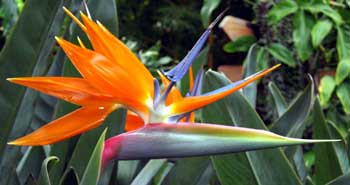 When we asked if he was the owner, he laughed and said, "Everyone thinks I own this place, except the bank." He had cedro rojo in all dimensions stacked in his covered mill yard, and another wood called conacaste, which he said was popular in Japan for flooring. When Rus asked to buy some samples for himself and to show friends back home in the wood business, Mynor had his workers put a few pieces through the planer to show the grain, and gave them to him. He's interested in exporting his lumber, as here in Central America it's all just wood, and priced accordingly. While we were talking his friend Jose Amilear, who owns a coffee plantation, dropped by to visit. Jose exports every single bean out of the country, and so does everyone he knows. That's why it's hard to find a good cup of coffee in Guatemala unless you go to a tourist cafe. We exchanged addresses with Mynor, and who knows where it will lead. When we asked if he was the owner, he laughed and said, "Everyone thinks I own this place, except the bank." He had cedro rojo in all dimensions stacked in his covered mill yard, and another wood called conacaste, which he said was popular in Japan for flooring. When Rus asked to buy some samples for himself and to show friends back home in the wood business, Mynor had his workers put a few pieces through the planer to show the grain, and gave them to him. He's interested in exporting his lumber, as here in Central America it's all just wood, and priced accordingly. While we were talking his friend Jose Amilear, who owns a coffee plantation, dropped by to visit. Jose exports every single bean out of the country, and so does everyone he knows. That's why it's hard to find a good cup of coffee in Guatemala unless you go to a tourist cafe. We exchanged addresses with Mynor, and who knows where it will lead.

Antigua parque central, unfortunately the fountain wasn't running
We were hoping to find a place to camp on the outskirts of Guatemala City and continue on the next morning, but it just didn't work out that way. We ended up driving all the way through that crazy city in the dark, and on into Antigua. This isn't something we'd recommend, but because we were on CA1 it was pretty much a straight shot, though the city seemed to stretch on forever. It was a tremendous relief to finally get regurgitated out the other side, and arrive at the gates of our old parqueo in Antigua, where the owner was glad to see us back (but not as glad as we were).
 Photo: Coffee in various stages of processing Photo: Coffee in various stages of processing
In the morning we took a taxi out to the Museo de Cafe, on the outskirts of Antigua, a place we'd intended to see our first time through but ran out of time. Guatemala is famous for its coffee, and this museum gives an excellent interpretation of the history and technology of the coffee business. It's also an operating organic coffee plantation. We were the only gringos in our tour group, but the guide generously spoke slowly so we could understand almost everything he said. There are exhibits of every step in the coffee-making process, a historical and economic analysis of 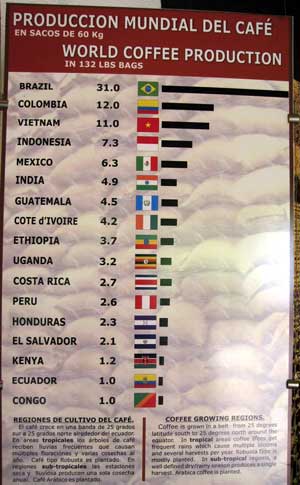 the coffee industry, and a huge collection of antique processing equipment, some of it hundreds of years old. Did you know that a coffee plant takes 4 years to begin producing, but then stays productive for 40 to 50 years? the coffee industry, and a huge collection of antique processing equipment, some of it hundreds of years old. Did you know that a coffee plant takes 4 years to begin producing, but then stays productive for 40 to 50 years?
Something else we didn't know is that Starbucks is largely responsible for increasing public awareness and appreciation of good coffee, which supports smaller scale farmers and the environment, as high-quality coffee is shade-grown and hand-picked over time as the beans ripen, rather than grown as a monoculture on huge plantations where the bushes are stripped clean instead of picked. It used to be so much fun hating Starbucks.
Revisiting Chichi
After checking our email and changing some dollars, we left Antigua to revisit Chichicastenango (her friends just call her Chichi), and the fabulous market there. The drive to Chichi is nearly as breathtaking as the market itself; we'd taken the chicken bus before, but this time had to negotiate those precipitous hairpin downgrades ourselves, the same ones where our bus driver had crossed himself. The next day, Sunday, was Chichi's big market day, and we wanted to buy gifts for our family and friends.
Arriving in town, we made for the Shell station just a block from the market, where we hoped to park in their lot. Unfortunately, they didn't have room for us, and directed us to a truck and bus parqueo at the edge of town. Resigned to an all-night parade of commercial traffic and diesel fumes wafting through our windows, we started off in that direction. But the guy from the gas station suddenly appeared and signaled us to enter a small gate off the street, which we did. (We never did figure out who he was, an angel perhaps?) We had to jockey a little to fit, then entered a gravel-covered lot with little kids running around, a litter of puppies and their mom, and a fantastic view of the mountains surrounding Chichi. The lot was bordered by a small compound of maybe three dwellings. We realized we were in someone's yard, but the price was fair, it was quiet and secure and very close to the market.
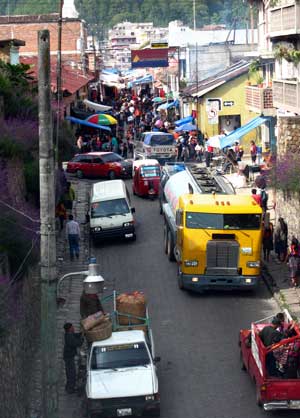 Photo: Imagine driving through these crowded streets of Chichi Photo: Imagine driving through these crowded streets of Chichi
We got ourselves situated for the evening, then took a walk into the center of town to watch the vendors setting up their stalls for the next day. It's always fun to watch the preparations for a big event, and the Chichi market is about as big as it gets in Central America. Most of the goods are packed in large round baskets with twine netting around them to keep the contents secure, or in huge cloth bundles. They're off-loaded from trucks and buses, then carried to individual stalls by porters using tump lines (ropes with leather forehead straps, which go around the load to support it on the porter's back). There's not even enough room for handtrucks here through the narrow, crowded aisles. Everyone involved in the set-up has done this hundreds of times before; it's an ordered chaos, and somehow everything ends up where it's supposed to be. We sat on the steps of Santo Tomas church for a while and watched the action unfold below, happy to be back in this lively, dynamic town.
 In the evening, back in our little parqueo, we got to know the owners a little, Diego and Estrella Blanca, a Mayan couple in their early 40's. They'd purchased this property about 6 years before, when Diego had a steady job as a truck driver. But recently he had major surgery and can't drive truck any more. They have 3 kids at home plus their daughter and her two small children have moved in with them (the daughter's husband left for California two years ago, but hasn't found steady work). This property is their ticket to a more secure life, but they're having a tough time holding on to it. Their 22-year-old son left for the U.S. several months ago to find work and is somewhere in Colorado; their faces showed their concern as they spoke of him. Photo: setting up for market Sunday morning In the evening, back in our little parqueo, we got to know the owners a little, Diego and Estrella Blanca, a Mayan couple in their early 40's. They'd purchased this property about 6 years before, when Diego had a steady job as a truck driver. But recently he had major surgery and can't drive truck any more. They have 3 kids at home plus their daughter and her two small children have moved in with them (the daughter's husband left for California two years ago, but hasn't found steady work). This property is their ticket to a more secure life, but they're having a tough time holding on to it. Their 22-year-old son left for the U.S. several months ago to find work and is somewhere in Colorado; their faces showed their concern as they spoke of him. Photo: setting up for market Sunday morning
Diego and Estrella Blanca were eager to learn what our opinions were on the issue of undocumented workers in the U.S. Many people we've met in Latin America, except for Costa Rica and Panama, have either been undocumented workers themselves, or have a family member in the U.S. now. It's opened our eyes to see the scope of this migration, and its profound effect on the families back home. Some parents we've talked to are worried sick they'll never see their kids again, as it's so hard to get over the border now. In Mexico, with about 10% of the population in the U.S., it's been a frequent topic of conversation. The money that undocumented Mexican workers send home from the U.S. is Mexico's second greatest source of revenue, behind petroleum exports. In Guatemala, it's the country's biggest source of income by far, again with about 10% of the population illegally in the U.S.. For Western Union, which handles the lion's share of the envios de dinero from the U.S. to Mexico and Central America, this has been the greatest windfall since they were offered (and refused!) the rights to the telephone.
 We hit the Chichi market early the next morning, in time to sit on the church steps and watch the sellers arrange their displays and the market come to life before our eyes. We decided to split up so Rus could shop and Kathleen could take photos, unhampered by the other, and to meet at an arranged time. Rus bought enough copal to supply the Vatican for a week and two pre-Columbian jade hatchet blades. Plus some beautifully woven belts. Kathleen bought a finely-made ceremonial huipil to hang on the wall at home and several other textiles. It was fun being back in that madhouse scene, a riot of color, with tourists and locals pressing their way through the narrow aisles between rows of stalls, vendors calling out, shoving things in your face and following you around with incredible persistence if you gave them so much as a smile. Kathleen bought an item she didn't even want just to get rid of a roaming vender who stuck to her like glue and went so low on the price she finally made the sale. We both learned to not look at these aggressive roamers, as they are a different breed from the sellers who have stalls. Though it feels rude, if you completely ignore them when they call out to you they'll go away soon enough. You can find anything for sale, from the finest antique hand-woven textiles and carved statues of saints to a Bob Marley t-shirt, from a Chinese toothbrush to a live turkey, in the Chichi market on Sunday. We hit the Chichi market early the next morning, in time to sit on the church steps and watch the sellers arrange their displays and the market come to life before our eyes. We decided to split up so Rus could shop and Kathleen could take photos, unhampered by the other, and to meet at an arranged time. Rus bought enough copal to supply the Vatican for a week and two pre-Columbian jade hatchet blades. Plus some beautifully woven belts. Kathleen bought a finely-made ceremonial huipil to hang on the wall at home and several other textiles. It was fun being back in that madhouse scene, a riot of color, with tourists and locals pressing their way through the narrow aisles between rows of stalls, vendors calling out, shoving things in your face and following you around with incredible persistence if you gave them so much as a smile. Kathleen bought an item she didn't even want just to get rid of a roaming vender who stuck to her like glue and went so low on the price she finally made the sale. We both learned to not look at these aggressive roamers, as they are a different breed from the sellers who have stalls. Though it feels rude, if you completely ignore them when they call out to you they'll go away soon enough. You can find anything for sale, from the finest antique hand-woven textiles and carved statues of saints to a Bob Marley t-shirt, from a Chinese toothbrush to a live turkey, in the Chichi market on Sunday.
 |
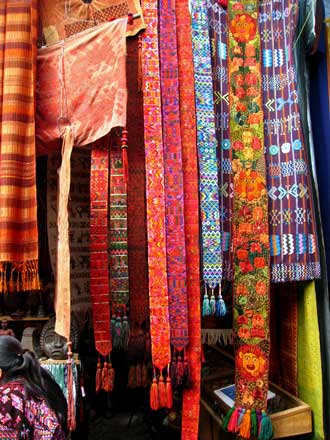 |
 Diego had offered to take us to a Mayan ceremonial site later in the afternoon, which we'd been unable to find the previous day. After a bite to eat and a short break we started out together through town, Diego greeting a good many of the people we passed. He is a Saserdote Mayan, has lived in Chichi his entire life and, like most Mayans in the highlands of Guatemala, he has lived through terrible circumstances. During the civil war, government-sanctioned paramilitary groups combed the countryside, murdering "rebel sympathizers" i.e., anyone who looked Mayan. Diego lost his mother, his father, and three brothers. He survived by hiding out in the forest until it was safe to return. The loss of his entire family as a young teenager has given him a strong attachment to his community and a deep spiritual connection. Diego had offered to take us to a Mayan ceremonial site later in the afternoon, which we'd been unable to find the previous day. After a bite to eat and a short break we started out together through town, Diego greeting a good many of the people we passed. He is a Saserdote Mayan, has lived in Chichi his entire life and, like most Mayans in the highlands of Guatemala, he has lived through terrible circumstances. During the civil war, government-sanctioned paramilitary groups combed the countryside, murdering "rebel sympathizers" i.e., anyone who looked Mayan. Diego lost his mother, his father, and three brothers. He survived by hiding out in the forest until it was safe to return. The loss of his entire family as a young teenager has given him a strong attachment to his community and a deep spiritual connection.
We wound down through the crowded streets to the edge of town, through some gardens and up a trail through pine forest to a ridgetop overlooking the city. There was smoke from some small fires at the far end, and a few people gathered there. In the center, on a patch of blackened earth, stood Pascual Abaj, a sooty unprepossessing stone about two and a half feet tall. Three rituals were taking place there at once: a man was having a healing, another man and his son were launching a business, and a couple were praying for protection for their son, who had recently gone to the U.S.. All of them had hired shamans, who were conducting these rituals with prayers, chants, copal, candles, tobacco and aguardiente (the potent local rotgut). The father who'd come to pray for his son was on his knees, sobbing as he prayed. Putting ourselves in his place, it was hard to watch.
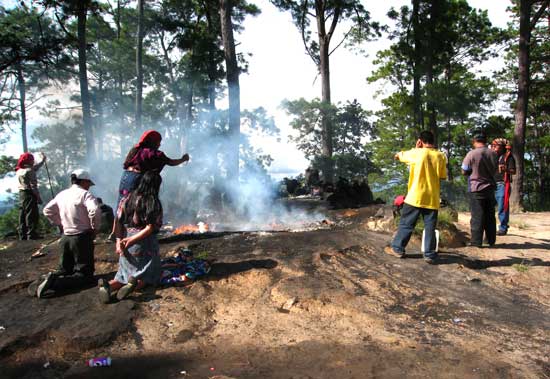
As we stood there, Diego told us that people come from all over Guatemala, and other countries too, to pray here and perform rituals. He described the ritual he had done for his own son before he left for the U.S.. They had come to Pascual Abaj, and to two other sacred sites in the region, for 15 consecutive days to pray together for his son's protection and success. When his son left, Diego returned by himself for 15 more days to complete the ritual. He said he often does ceremonies here for others, and that people in town come to Estrella Blanca as well, who has an altar at home. Kathleen had wanted to meet a shaman on our trip, and here we were, with two as our hosts! We thought back to the guy who'd appeared out of nowhere to open the gate to Diego and Estrella Blanca's parqueo and wondered....................... The Mayan people live much closer than we do to the spirit world; what we call "magic" is for them an ordinary occurrence, and central to their lives.
We lingered there at Pascual Abaj for a while, fascinated, watching the ceremonies draw to a close, then Diego asked if we'd like to see Santo Tomas, the patron saint of Chichicastenango, on the way back. We hiked back to an enclosed compound at the edge of town, and Diego ushered us into a candlelit room with a large, beautifully clothed Santo Tomas in a glass case at the far end. The entire room was a shrine to the saint: large dipped candles were burning in the room and unlighted ones hung in bunches all around the walls, flowers and offerings were heaped on a large table in the center, the entire ceiling was covered in cut streamers, and three elders were sitting near the entrance as guardians to the patron saint. Diego had been one of them the previous year, and spoke to the men in his native tongue while we paid our respects to Santo Tomas and made an offering. One of the guardians unlocked the glass case to place it in the Saint's extended hand.
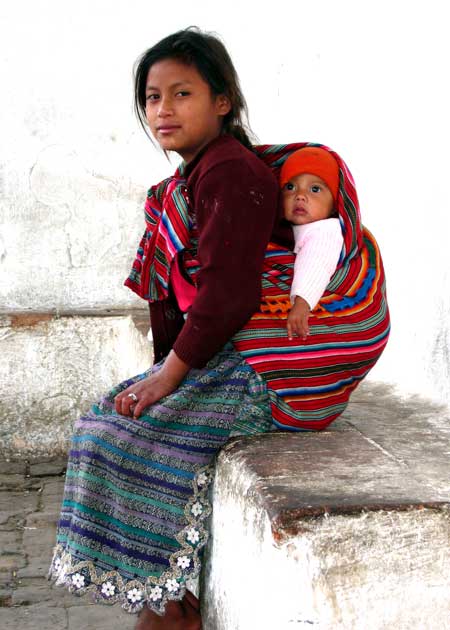 Until recently, this case wasn't kept locked, and a few years ago a small image of Santo Tomas as a boy had turned up missing around the time a group of Japanese tourists had been in the room. A replacement is there on loan from another town, but they hope some day the original will be returned. Another small image in the case is privately owned, and when the owner decided recently to take it home, he was stricken with insomnia. A few months later the sleep-deprived owner returned the image permanently to its case and went home to bed. We told Diego we hoped the stolen image was passing from one insomniac collector to another, and that it would eventually find its way home. Until recently, this case wasn't kept locked, and a few years ago a small image of Santo Tomas as a boy had turned up missing around the time a group of Japanese tourists had been in the room. A replacement is there on loan from another town, but they hope some day the original will be returned. Another small image in the case is privately owned, and when the owner decided recently to take it home, he was stricken with insomnia. A few months later the sleep-deprived owner returned the image permanently to its case and went home to bed. We told Diego we hoped the stolen image was passing from one insomniac collector to another, and that it would eventually find its way home.
Photo: 9 year old Maria and her baby sister, Catarina, 6 months old
After our visit to Santo Tomas, Diego left us to run some errands, and we went back to the church steps to watch the market as it was winding down. A beautiful little girl, Maria, that Kathleen had spoken with and photographed that morning came up to say hello. It was about 8 or 9 hours later but she still carried her little sister, Catarina, on her back. We talked a little, but mostly just sat together in silence. Another girl joined us, about the same age, shy and dressed in ragged clothes, with unkempt hair and bad teeth. They didn't seem to know each other. We found out that Maria takes care of her sister while her mom works, making tortillas by hand in the food section of the market. Her dad "lives in another town right now". In another five years, the baby on her back might be her own; it's not uncommon here.
A little aside here about photographing indigenous people here. Although as a rule, they refuse to have their pictures taken, cameras seem to be accepted in parts of the Chichi market. Tourists have been enjoying this photo fest for years, and it would be hard to stop them. Earlier that day when Kathleen motioned to Maria with her camera asking to take her photo, Maria held her hand up indicating five, five quetzales. Kathleen gave it to her, Maria sat on the church ledge, and Kathleen pressed the shutter (photo above). Later Maria tracked her down through the stalls and explained that one of the elders had told her to ask for money. Kathleen was surprised and touched that she seemed to be apologizing.
The four of us and Ziggy sat on the church steps together a while longer until it was time for us to go. Kathleen felt an urge to do something for the girls and Rus suggested buying them an horchada from a vendor who had set up at the foot of the steps below. The girls eyes opened wide, they nodded, yes, they'd like it, and followed us down, climbing up on the plastic stools next to the other customers. There was no horchada (a Mexican drink), this place served arroz con leche, a nutritious drink made from milk, rice flour, sugar and spices. The girls sat there holding their glass mugs but not drinking, looking a little stunned. Kathleen paid for the drinks, kissed each girl, and the baby too, on the tops of their heads and we left. The little ragged one looked as if she'd been kissed by the Queen of England.
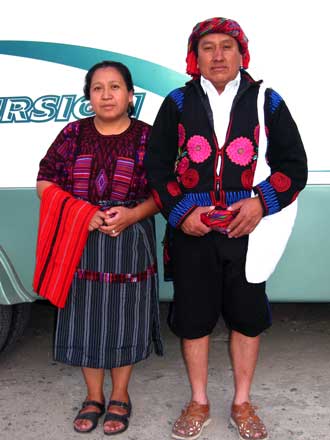 We returned to Diego and Estrella Blanca's place, as they'd offered to show us their traditional clothing. They are both involved in Chichicastenango's ceremonial hierarchy, and the previous year had been elected to positions, we're not quite sure what, which required them to buy new traditional (and expensive) handmade ceremonial clothing specific to the city of Chichicastenango and their position. Our hosts asked us to wait a few minutes while they bathed and prepared, and when they emerged they both looked grand, beautiful, and very dignified, in outfits you'll never see for sale in the market. We returned to Diego and Estrella Blanca's place, as they'd offered to show us their traditional clothing. They are both involved in Chichicastenango's ceremonial hierarchy, and the previous year had been elected to positions, we're not quite sure what, which required them to buy new traditional (and expensive) handmade ceremonial clothing specific to the city of Chichicastenango and their position. Our hosts asked us to wait a few minutes while they bathed and prepared, and when they emerged they both looked grand, beautiful, and very dignified, in outfits you'll never see for sale in the market.
They wanted us to take pictures of them in their ceremonial dress to send to back later when we could. Kathleen was overjoyed. She'd been suffering (and cheating just a wee bit when backs were turned) to keep her camera in her pocket all these weeks around the colorful indigenous people of Mexico and Guatemala. Diego and Estrella Blanca chose our rig as their preferred background; we preferred their home and took some of both. Then Diego asked if we'd like to dress up in some additional outfits they had. Knowing a little about what the traditional ceremonial dress means to the Mayan people, we said no at first, but they seemed excited to share what was meaningful to them, so why not? But something got lost in the transition from Mayan to Anglo Saxon, and both of us looked a little like costumed gangly chickens compared to their solid dignity!
 Afterwards, we gave Diego and Estrella Blanca a large wall map of the United States that we'd brought along, which they were very grateful for, as everyone has friends and family in the U.S. They knew their son was in a place named Colorado, but they had no idea where it was. We also gave them $20 in appreciation for Diego being our guide that afternoon, which he kissed and held up to the sky in appreciation. Their lives are rich and full, but money is something they sorely lack; it's not very much to us, and makes a big difference to them. Afterwards, we gave Diego and Estrella Blanca a large wall map of the United States that we'd brought along, which they were very grateful for, as everyone has friends and family in the U.S. They knew their son was in a place named Colorado, but they had no idea where it was. We also gave them $20 in appreciation for Diego being our guide that afternoon, which he kissed and held up to the sky in appreciation. Their lives are rich and full, but money is something they sorely lack; it's not very much to us, and makes a big difference to them.
The morning of our departure, we came out just as Diego was leaving to take his twin sons to school. We said we were leaving pretty soon; maybe we should say good-bye now. Diego said, can you wait ten minutes? I'll be right back, and we said sure. When he returned he held a brown paper bag in his hand, and he and Estrella Blanca motioned us to follow them into their house. They pulled back a curtain over a doorway, and before us was one of the most beautiful altars we've ever seen. The entire room was devoted to it; a long table was decorated with candles, flowers, natural objects and the images of saints; more covering the walls above and all around the room. We were stunned. However simply this family lived in the material world, and whatever hardships they endured, this was the realm in which they pulled out all the stops, and the exuberance of their lives shone brightly.

Chichi cemetery
Diego invited us to the front of the altar and took two candles out of the brown bag. He stood beside us, and Estrella Blanca stood behind. Then they knelt down, we followed, and Diego began to pray, asking God to protect us on our journey home. It was a long prayer, greeting the saints and the Virgin Mary and thanking them for their blessings and protection thus far. He remembered everything we'd told him about our trip and outlined our whole journey, mentioning special places we'd enjoyed, country by country. Then he traced our entire route back to the U.S., praying for our safety along each step of the way. He held a red candle as he prayed and placed it on the altar and lit it. Picking up the white candle he began again, blessing Rus, the driver, asking for good conditions, helpful people, no mechanical failures or accidents. A safe trip home. And still kneeling he turned to bless Kathleen, asking that she arrive safely back to our three sons who were waiting for her, that she be healthy and happy, mentioning her love of nature and beauty. She felt REALLY listened to. Then he lit the white candle and placed it on the altar next to the red one. They were the kind in tall glasses, that burn for days. When he finished, he and Estrella Blanca rose, we rose too, they turned to us and gave us both long embraces. Our hearts were filled to overflowing, tears welling in our eyes as we said good-bye. Diego rode with us a short ways to guide us to the road out of town, then he walked back home. We drove through the mountains in silence for a long while, our spirits soaring.
And back through Mexic0 again.....
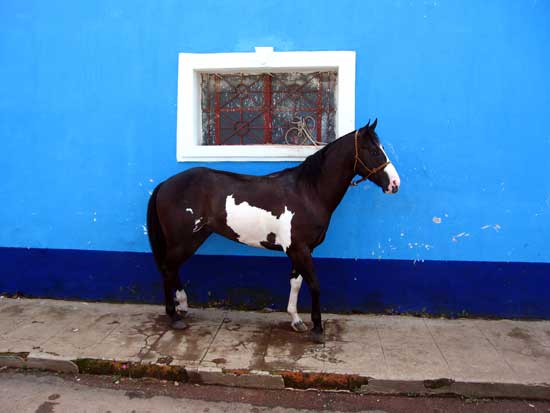
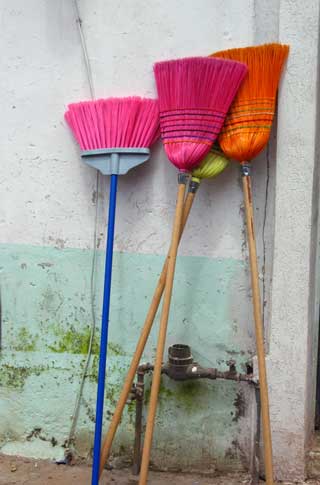 The drive to the Mexican border, was beautiful and rugged, we took back roads as far as Quiche. We'd been told there was a new road from there to the border, but the only signs of it were just that: signs posted that a highway project was in the works. We crossed again at La Mesilla, and not a single transito rushed over to pester us, a sure sign that Diego's prayers for us were working. The smooth crossing gave us plenty of time to reach our old camp at San Cristobal de las Casas before dark, where the resident dog was overjoyed to see us again. The drive to the Mexican border, was beautiful and rugged, we took back roads as far as Quiche. We'd been told there was a new road from there to the border, but the only signs of it were just that: signs posted that a highway project was in the works. We crossed again at La Mesilla, and not a single transito rushed over to pester us, a sure sign that Diego's prayers for us were working. The smooth crossing gave us plenty of time to reach our old camp at San Cristobal de las Casas before dark, where the resident dog was overjoyed to see us again.
We'd originally planned to follow Mexico's Gulf Coast up to Texas and take advantage of the good roads in the U.S. to make time back to California. But we were enjoying Mexico, in fact savoring it, and were not especially in a hurry to be back in the U.S. The Mexican highways were plenty good if we splurged and took the toll roads. So we changed our route, crossing over the Central Highlands toward the Pacific coast, north to Guaymas then up to Nogales. Following this route we rediscovered Mexico, as beautiful as any country in Central America, much larger and far less densely populated. Crossing over the highlands (except for the 5-hour Mexico City bypass), we needed another response to the landscape; we wore out OhMyGod!
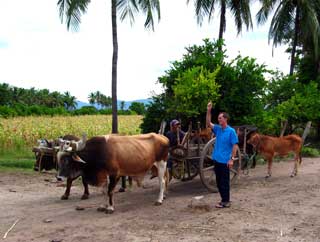 Photo: ask a local for directions, you'll usually get a lot of "por alla" (over there) and gesturing wildly Photo: ask a local for directions, you'll usually get a lot of "por alla" (over there) and gesturing wildly
We had our truck serviced in a fancy new Ford dealership in Tuxla Gutierrez, drove west until nearly dark, then talked a very reluctant motel owner in Tapanatepec into letting us park for the night for 100 pesos. He didn't want us to take up parking space for his motel customers, though at this point there were none. We didn't understand his logic but he finally understood ours.
Next morning we continued on highway 190 over the mountains toward Oaxaca. Maybe it was the mind-blowing perfection of the green landscape that diverted our attention, but we nearly ran out of fuel miles from any town big enough to have a station. The locals saved us, saying a man down the road a ways had diesel for sale (no sign, you had to know). The price was fair but we would have bought the 20 liters at any price.
 Since we'd missed it on our way down we had to stop and see the El Arbol del Tule in the pretty town of Santa Maria del Tule south of Oaxaca. Reported to be the largest tree in the world, it is over 164 feet high and 161 feet in circumference. Over 2,000 years old, this massive Mexican cypress is hard to take in visually and impossible photograph in entirety. It dwarfs the church nearby and is obviously well loved and cared for inside a fenced rose garden, admission 3 pesos or 30 cents. We took a short detour to San Bartolo Coyotepec to see Dona Rosa Nieto's black pottery shop, now run by her descendants, where we bought a large classically shaped pot and some presents to take home. We parked that night and the next in Pemex stations. Sometimes on long days of driving hard all we need is a safe place to lay our heads. We fill up first and always ask permission and usually have the company of another truck or two. Photo above: El Arbol del Tule makes Rus look very small Since we'd missed it on our way down we had to stop and see the El Arbol del Tule in the pretty town of Santa Maria del Tule south of Oaxaca. Reported to be the largest tree in the world, it is over 164 feet high and 161 feet in circumference. Over 2,000 years old, this massive Mexican cypress is hard to take in visually and impossible photograph in entirety. It dwarfs the church nearby and is obviously well loved and cared for inside a fenced rose garden, admission 3 pesos or 30 cents. We took a short detour to San Bartolo Coyotepec to see Dona Rosa Nieto's black pottery shop, now run by her descendants, where we bought a large classically shaped pot and some presents to take home. We parked that night and the next in Pemex stations. Sometimes on long days of driving hard all we need is a safe place to lay our heads. We fill up first and always ask permission and usually have the company of another truck or two. Photo above: El Arbol del Tule makes Rus look very small
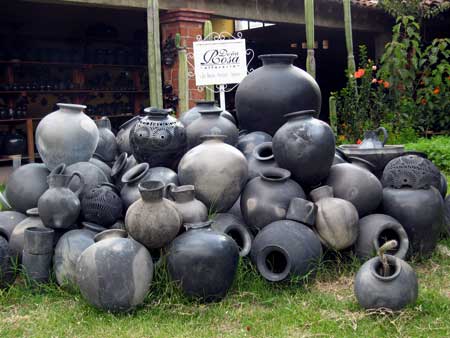 We couldn't figure out what we were seeing at first, driving through Oaxaca. Black piles of ash in the middle of the street at certain intersections, then remnants of burned tires and mattresses. Finally it began to make sense, these were the sites of protests, some still smoking from the night before. Crowds of people gathered here and there where signs had been hand-painted on walls, trucks or billboards, calling the governor a murderer of women and children. People looked angry. Not far north of town we saw a large gathering at the collection booth for a toll road. As we approached we could hear shouting and people began waving us through. The people had taken over the tollbooth and were letting everyone drive for free. Toll roads here are so expensive the average Mexican can't afford to use them. We cheered with them as we passed. We couldn't figure out what we were seeing at first, driving through Oaxaca. Black piles of ash in the middle of the street at certain intersections, then remnants of burned tires and mattresses. Finally it began to make sense, these were the sites of protests, some still smoking from the night before. Crowds of people gathered here and there where signs had been hand-painted on walls, trucks or billboards, calling the governor a murderer of women and children. People looked angry. Not far north of town we saw a large gathering at the collection booth for a toll road. As we approached we could hear shouting and people began waving us through. The people had taken over the tollbooth and were letting everyone drive for free. Toll roads here are so expensive the average Mexican can't afford to use them. We cheered with them as we passed.
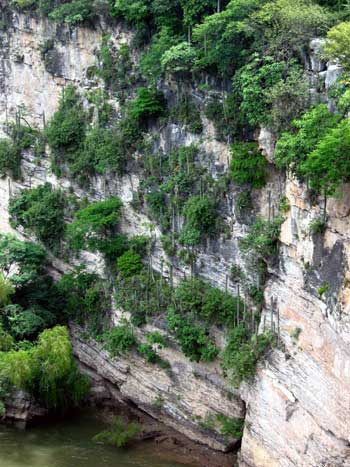 In Morelia we left Ziggy at our campsite in the parking lot of Wal-Mart, windows open and fans on, and took a taxi to the center of town. What a beautiful colonial downtown, all the buildings made of pink stone, with arched verandas facing the expansive zocalo and a grand cathedral towering above. In Morelia we left Ziggy at our campsite in the parking lot of Wal-Mart, windows open and fans on, and took a taxi to the center of town. What a beautiful colonial downtown, all the buildings made of pink stone, with arched verandas facing the expansive zocalo and a grand cathedral towering above.
At the cathedral (it was Saturday morning) signs of a wedding were evident, clusters of people gathering outside dressed in fancy clothes, inside confessions were being held. As we sat in a pew to be still for a minute, our attention turned to a long line at the confessional where a woman was kneeling outside the booth telling her sins to an ancient looking priest. He, inside the open booth, was fast asleep, head back, mouth open, actually snoring. We watched him a while. He stirred and then muttered something, the woman got up and as soon as the next person started confessing he went back to sleep again. Photo: Cactus growing among the bushes on the cliff
At this point in our trip we were more interested in making miles than sightseeing so we booked it back to Ziggy and headed the rig toward, then around Guadalajara, using toll roads whenever we could. The driving was easy but for approximately 200 miles we paid $64 (U.S.) in tolls. We stayed that night a few miles off the highway at a campground beside a small crater lake called Laguna de Santa Maria del Oro (photo below).
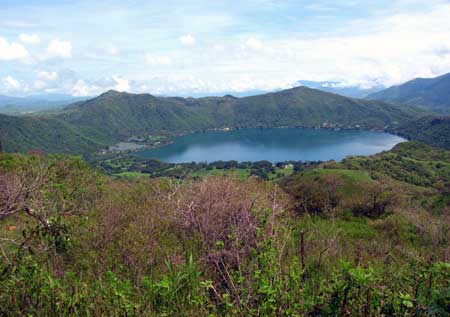 We'd left Panama on August 11, and reached Mazatlan, on Mexico's Pacific Coast, on the 27th. We'd driven 3,000 miles, with another 2,500 easy ones to go, so arriving in Mazatlan we lingered a couple of nights, and a couple more in San Carlos, near Guaymas. San Carlos, on a lovely bay in the Sea of Cortez, is only a day's drive from Tucson. There was even another American rv in our campground! We ran out of dog food there, and after weighing the options, it was cheaper to buy Ziggy a t-bone steak dinner in the restaurant than take a taxi to the market. She didn't seem to mind, and even ate the cauliflower. We'd left Panama on August 11, and reached Mazatlan, on Mexico's Pacific Coast, on the 27th. We'd driven 3,000 miles, with another 2,500 easy ones to go, so arriving in Mazatlan we lingered a couple of nights, and a couple more in San Carlos, near Guaymas. San Carlos, on a lovely bay in the Sea of Cortez, is only a day's drive from Tucson. There was even another American rv in our campground! We ran out of dog food there, and after weighing the options, it was cheaper to buy Ziggy a t-bone steak dinner in the restaurant than take a taxi to the market. She didn't seem to mind, and even ate the cauliflower.
The next day he August sun baked down on that land of bare rock, and our rv park became an oven. It was so hot we were confined to our rig with the air conditioner on, doing laundry and working on the website. We didn't emerge until sunset, when we walked over to the restaurant again, and Ziggy enjoyed another fine meal, as we still hadn't bought dog food. Lots  of Americans and Canadians come here during the tourist season (NOT now), and we enjoyed the amenities provided for them: enough voltage to run our air conditioner, a good wi-fi connection, and margueritas made from scratch. of Americans and Canadians come here during the tourist season (NOT now), and we enjoyed the amenities provided for them: enough voltage to run our air conditioner, a good wi-fi connection, and margueritas made from scratch.
Photo, right: El Mirador at Huatabampito, Sonora has RV spaces with hookups
Our final run to the Arizona border was through the desert landscape that many people associate with Mexico, but it seemed unfamiliar to us, nothing like the lush, green country we traveled through for months. Crossing into the U.S. at Nogales, the highway immediately widened, the asphalt instantly smooth and dependable, shoulders wide enough to be of use. We noticed too that the homes and buildings were bigger, well constructed and maintained. Everything looked clean and orderly. More than ever before, we saw how wealthy our country must look to a poor person from Mexico or Central America, and why people are willing to risk so much to come here, and work so hard for the table scraps from America's bounty.
By the way, you can't bring more than one day's dog food across the US border. We were glad we'd fed Ziggy steak. And she was too.
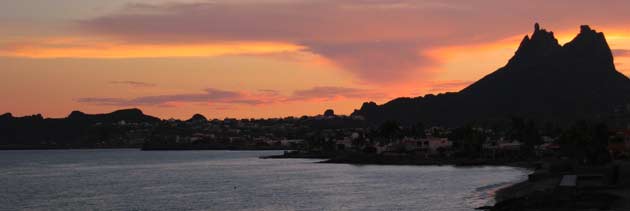
Sun sets over San Carlos Bay
The United States of America
We stopped at the home of Rus' parents, Marge and Les, for a quick visit before heading north to our home town. They had generously offered the use of an extra car, a racy little Plymouth Lazer, while we were back in the States, so we drove the rest of the way to Humboldt County in convoy, arriving a week before our son Jamie's wedding. We stayed a week at a KOA campground, sterile feeling and expensive compared to the beautiful places we'd camped the previous months. But then we moved onto the lovely property of our son Jordan's girlfriend Faye and her parents Andi and Lisa, who own an organic flower farm just a few hundred yards from the ocean. We had a wonderful time there and became good friends with Andi and Lisa, who invited us to share delicious lunches and dinners with them. On workdays, they and their workers all ate family style at the long table made from a single walnut tree from their previous farm.
 We'd driven over 5500 miles from Panama for our son Jamie's wedding, and what a wedding it was. Larissa (Jamie's bride and our new daughter-in-law) is a striking young woman, and looked stunning on her wedding day. The ceremony was held outdoors in an apple orchard, on a perfect Indian summer afternoon. As we witnessed our son taking this huge step in his life, tears of joy and pride streamed down our faces, love and support flowed out to them from both families and their many friends. We danced for hours with everyone, especially with Larissa's big family, all great dancers. We ate good food, drank good wine, made speeches, laughed, loved and closed the place down. It felt great to be among so many exuberant young people, many of whom we've known since they were in high school or long before. We'd driven over 5500 miles from Panama for our son Jamie's wedding, and what a wedding it was. Larissa (Jamie's bride and our new daughter-in-law) is a striking young woman, and looked stunning on her wedding day. The ceremony was held outdoors in an apple orchard, on a perfect Indian summer afternoon. As we witnessed our son taking this huge step in his life, tears of joy and pride streamed down our faces, love and support flowed out to them from both families and their many friends. We danced for hours with everyone, especially with Larissa's big family, all great dancers. We ate good food, drank good wine, made speeches, laughed, loved and closed the place down. It felt great to be among so many exuberant young people, many of whom we've known since they were in high school or long before.
And that brings this segment of our travels to a close. We'll be back on the road with more stories later.

Bye, bye!
|

